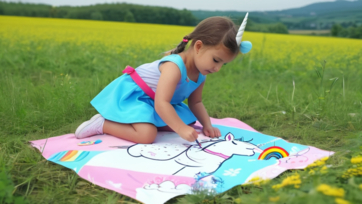Let’s Learn Colors Through Play

Learn Colors Through Play
Let’s Learn Colors Through Play
Recognizing and learning colors is one of the first basic skills children begin to acquire at an early age. The world of colors is not only fun and exciting, but it also plays a crucial role in children’s development, helping them to understand and organize their surroundings. But how can we make learning colors even more enjoyable and effective? The best way is to teach them through playful activities and involve them in the process. Knowledge gained through play is always deeper and more lasting!
Colorful games – the foundation of creative learning
One of the best ways to teach colors is by choosing games that are colorful, varied, and engaging for children. Little ones love colorful building blocks, puzzles, and other creative toys that not only help them recognize colors but also improve their motor skills, creativity, and problem-solving abilities.
For example, while building a tower with colored blocks, you can ask your child to pick out the red block, or you can build a tower where each floor is a different color. As the game progresses, children will not only learn the names of colors but also experience the differences between shades. This gradually expands their color palette, and they’ll easily recognize and name different hues, such as light green and dark green or light blue and dark blue.
Colorful slime – the power of experiential learning
Another highly entertaining way to learn colors is by making slime. Kids love slime because it’s colorful, stretchy, and endlessly moldable. And while they play, they’re learning without even realizing it! You can make different colored slimes together, and while doing so, discuss what colors you’re using. Children will enjoy mixing the colors and, in the process, learn important concepts like color blending. For example, when you mix blue and yellow, they’ll discover how it turns into green. This visual and hands-on experience gives them a deeper understanding of the world of colors.
Crafting with colored paper
Crafting is another excellent way to explore and practice colors. Take out different colored papers, scissors, and glue, and create simple shapes like flowers, houses, or even animals. As you work, name the colors you’re using and talk about where each color fits. For instance, the petals of a flower could be red or yellow, while the leaves are green. These crafting activities not only help with color recognition but also enhance fine motor skills, creativity, and patience.
Colors in everyday life
Don’t forget that colors are all around us, so learning can continue anytime, anywhere! For example, while you’re out on a walk, talk about the colors of the flowers, the leaves on the trees, or the cars on the street. These everyday conversations make learning more playful and enjoyable, and children can easily connect what they’ve learned to their environment.
Conclusion
Teaching colors through playful activities is not only fun but also a very effective way to learn. Whether you’re using building blocks, slime, or craft projects, children love participating in activities where they can freely play and create. While discovering the world of colors, children don’t just learn the names of colors, but they also develop creative thinking, organizational skills, and the ability to apply experiential knowledge in everyday life.